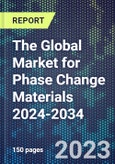Phase Change Materials (PCMs) are thermal compounds that absorb and release thermal energy during phase transitions between solid and liquid. This allows effective thermal storage and temperature regulation. A wide range of PCMs have been developed including organic (paraffins and fatty acids), inorganics (salt hydrates and metallic) and eutectic mixtures of organic and/or inorganic materials. PCM products are used to improve whole-building energy efficiency in retail, commercial, hospitality, and industrial applications; enable safe transport of sensitive food and pharmaceutical products; and provide enhanced thermal storage capabilities for industrial and commercial processes, among other applications.?
The Global Market for Phase Change Materials 2024-2034 provides a comprehensive analysis of the global phase change materials (PCMs) market. The report covers PCM types including paraffins, fatty acids, salt hydrates, eutectics, and metallics. Applications in buildings, cold chain, electronics cooling, textiles, aerospace, automotive, and energy storage are assessed.
The report provides PCM global market revenues, regional market breakdowns, growth drivers, trends, technology overview, SWOT analysis, pricing, patents, and profiles 60 leading PCM manufacturers.
Multiple tables summarize key properties, advantages/disadvantages, applications, and market metrics for major PCM technology segments. Future outlook assesses opportunities in encapsulation, bio-PCMs, heating/cooling integration, electronics substrates, medical textiles, building integration and cold storage.
The report helps decision makers in the PCM value chain including materials suppliers, heating/cooling OEMs, electronics brands, logistics providers, architects, and specialty chemical companies understand the fast-growing multi-billion dollar PCM market and identify new application and partnership opportunities.
Report contents include:
- Overview of phase change materials, their properties, classification, and applications.
- PCM market size, growth drivers, competitive landscape, developments, opportunities.
- Working principle, types of PCMs, encapsulation methods, comparative analysis.
- Thermal energy storage concepts.
- Recent patents related to PCM technologies.
- Cost ranges for different PCM types.
- Total PCM global market size and forecasts. Breakdown by market segments and regions.
- PCM adoption in buildings, electronics cooling, cold storage, textiles, aerospace, automotive etc.
- Profiles of 60 companies manufacturing various types of PCMs. Companies profiled include Axiotherm GmbH, Climator Sweden AB, HeatVentors, i-TES, Kaneka, Lightstandard Technology, PureTemp LLC, Rubitherm Technologies, and Swave Photonics NV.
This product will be delivered within 1-3 business days.
Table of Contents
Companies Mentioned (Partial List)
A selection of companies mentioned in this report includes, but is not limited to:
- Advanced Cooling Technologies, Inc.
- AI Technology Inc.
- Andores New Energy Co., Ltd.
- Axiotherm GmbH
- Azelio
- BioLife Solutions, Inc.
- Bodle Technologies Ltd.
- BOCA-PCM
- Boyd Corporation
- CCT Energy Storage
- Climator Sweden AB
- Cowa Thermal Solutions AG
- Croda Europe Ltd.
- Cryopak
- Datum Phase Change Ltd
- Devan Chemicals NV
- Encapsys LLC (Milliken & Company)
- Enesoon New Energy Co. Ltd
- Ewald Dörken AG
- Global-E-Systems Europe
- Hangzhou Ruhr New Material Technology Co., Ltd.
- HeatVentors
- Henkel AG & Co. KGAA
- Insolcorp LLC
- Inuteq
- i-TES
- Kaneka
- KULR Technology Group, Inc.
- Lightstandard Technology
- Microtek Laboratories, Inc.
- Parker Hannifin Corporation
- PCM Technology
- Phase Change Material Products Ltd.
- Pelican BioThermal LLC
- Phase Change Products Pty Ltd (PCP)
- Phase Change Energy Solutions Inc.
- PLUSS Advanced Technologies Pvt. Ltd.
- Promethean Power Systems, Inc
- PureTemp LLC
- RGEES, LLC
- Rovilus, Inc.
- Rubitherm Technologies GmbH
- Salca BV
- Sasol Germany GmbH
- Seatrec
- Schoeller Textiles AG
- Shanghai Tempered Entropy New Energy Co.
- Shenzhen Aochuan Technology Co., Ltd.
- Sonoco Thermosafe
- Shin-Etsu Chemical Co. Ltd.
- Stasis Energy Group LLC
- Sundanzer
- Sunamp Ltd.
- Suntherm ApS
- Swave Photonics NV
- Tan90
- Techniche International
- va-Q-tec AG
- Viking Cold Solutions, Inc.
Methodology

LOADING...








